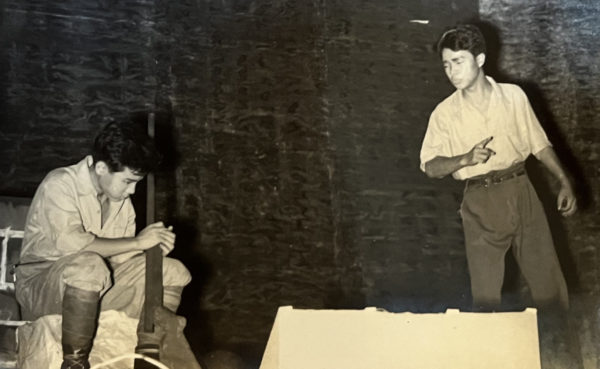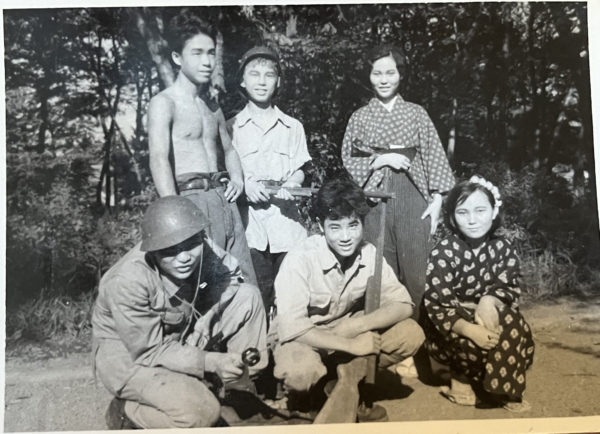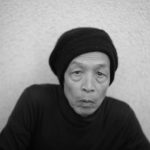笠井叡 舞踏をはじめて <2>
Akira Kasai Begins Butoh <2>
Akira Kasai studied under Kazuo Ohno, interacted with Tatsumi Hijikata, and gave birth to the word "butoh". He will talk about his life and his own butoh.
I attended Musashino Gakuen for elementary school and Sansui Gakuen for junior and senior high school after passing the junior high school entrance exam. The school was once for the militaryserviceman's children, but its name was changed and is now known as Toho Gakuen. The school is known as a music school as well as a general education school.
Under the influence of Mr. Yoshikawa, I joined the drama club in junior high and high school. I often visited the theater, but I didn't really like popular theater productions, so I mainly watched Bungakuza and Haiyuza. Even as a child, I was interested not only in the plays themselves, but also in how society was changing through the stage.
In junior high school, I was even more passionate about mountains than I was about theater, and I joined the mountaineering club in addition to the theater club. It was also Mr. Yoshikawa who led me to the mountains. I loved high mountains, especially those covered in snow and ice, and I was passionate about challenging myself on difficult rocky peaks. It would be like rock climbing nowadays. For example, if you look at his handbook one year, there is a record of him going to the mountains alone for almost 30 days during summer vacation.
I did quite a bit of dangerous things and nearly lost my life. When I was in the third year of junior high school, I climbed Mt. Tanigawa with three other adults, and just as we were about 500 meters away from reaching the summit, we ran into a precipice and got stuck. In addition, there was a heavy snowstorm, and we decided to spend the night digging a hole in the snow to stay in. However, when he woke up the next morning, the blizzard was still continuing. While climbing up a rocky hill in the blizzard, a surface avalanche occurred, and four people fell down the slope, still on their nopes, and were buried in the snow. Unable to breathe, we wondered if we were going to die. Apparently, another large avalanche had occurred nearby, and in reaction, the snow that had trapped us was rotated and pushed us out, enable us to see the sky. After Tanigawa-dake, I quit mountain climbing. However, the mountains were an important place for me, and I had a great deal of experience there.
Theater and mountains occupied most of my time in junior and high school. While my older sister and younger brother were very bright and had already decided on their career paths, I had no clear vision for my future and had no desire to go to college, even though I was about to graduate from high school.
I more or less studied for the entrance examination, but I had no dreams of what I wanted to become, and I didn't put much effort into my studies. I even considered becoming a stage actor. I tried taking the exams for the Haiyu-za and Bungaku-za training schools, but the results were entirely hopeless and didn't open a path in the theater for me. Eventually I realized that the linguistic expression available in theater was not what I was looking for, and I began to think that even theater was not good enough. What is the world that excites me, the world that I can put my life on the line for? After eliminating them one by one, what remained was the path of dance.
After graduating from high school, I spent two years as a ronin (without job, education). However, even during that time, I did not study hard for the entrance examinations, but spent my days dancing at the Takaya Eguchi and Misako Miya Dance Institute.
Takaya Eguchi and Misako Miya are leading figures in the Japanese modern dance world, having studied under Mary Wigman, founder of the Neue Tanz. After returning to Japan, they set up their own studio and taught modern dance in parallel with their stage activities.
Mr. Eguchi taught on Mondays, Wednesdays, and Fridays, and his wife Mrs. Miya on Tuesdays, Thursdays, and Saturdays. Mr. Eguchi was a very handsome man, and Mrs. Miya was also a very beautiful woman. They were very well matched, but their types were completely different.
A large part of Mr. Eguchi's practice was movements to prepare the body and improve flexibility. The students lined up in three rows and walked 1, 2, 3, 4 to the piano played by the pianist, where they paused for one pose. ...... Mr. Eguchi would demonstrate a modern dance-like movement, and everyone would imitate it and improvise. Mr. Eguchi was already over 60 years old at that time, but he was very energetic. I remember that he taught the one-and-a-half hour lesson without taking a break, moving energetically on his own.
Mrs. Miya's dance was characterized by a kind of passionate movement. It could be tango-style or flamenco-style. Mr. Eguchi's movements were flexible and evenly distributed, but Mrs. Miya's were very intense, stretching upward and then suddenly relaxing. Mr. Eguchi's movements gradually become more powerful as he moves from 1, 2, 3, 4......, but Mrs. Miya's movements were very powerful from the very beginning. That is why the way they look is totally different. Mrs. Miyai's personality was also very intense, while Mr. Eguchi was more of a mild-mannered type.
Shortly after I joined the class, we were to perform "Oni Kenbai" (Oni Sword Dance). It is said to be one of Mr. Eguchi's masterpieces. I had just started learning dance, but Mr. Eguchi asked me, "Mr. Kasai, let's practice choreographing with me," and I ended up choreographing with him. We choreographed one by one, with legs spread wide and jumping, and created the stage together with Mr. Eguchi. I felt like I was being personally trained, and it was a very enjoyable time for me.
Although I was taking lessons, I had no intention of becoming a dancer, and I spent many days wondering what I should be doing. One day, I asked Mr. Eguchi, "What should I do? He said, "It depends on how you think. I can't tell you that! He scolded me severely. I had expected him to say, like "It's all right, son".
Along with modern dance, I also attended ballet classes. The teacher who taught me ballet was Akinori Chiba. In private lessons, he taught floor barre, which was still unknown in Japan at the time.
Mr. Chiba was a person who was very particular about the core of the body. For example, when building a house, if you do not put beams in the four corners, the house will be unstable, but the same is true for the body. Strangely enough, I felt as if I was getting taller after taking Mr. Chiba's lessons. I felt that my body was indeed changing at every lesson.
The lesson fee was quite expensive, I think 7,000 to 8,000 yen for one 20-minute lesson. Even so, it must have been worth it, as even famous dancers came to learn in secret. I went for one year, but the lesson fee money did not last any longer than that.
I got my first dance job through. the relationship with the Takaya Eguchi Misako Miya Dance Institute. Unexpectedly, dance became my livelihood.
There were a few male students at Mr. Eguchi's practice hall, including Takashi Nishida, Hirotoshi Shoji, and Yataro Mikami. One of my closest friends was Masayoshi Yoshitsugu. His father was a dance teacher in Sakata, and he studied at Mr. Eguchi's training hall at the same time. One day, Mr. Yoshitsugu invited me to start working in television program. It was a NHK's program for children produced by the production company named Kamoshika. My job was dancing and moving body behind performers singing songs.. It was a 30-minute program and the remuneration was about 1,000 yen. At the time, that was how I made my living partly.
There were several dance classes in the Kamoshika Productions training, and the teacher who taught pantomimes there was Mr. Jean Nouveau. He is a genuine Japanese, and his real name is Junzo Ota. Mr. Jean told me, "I will teach you pantomime," and I began to learn mime. Through mime, I learned that there is not only a difference in movement, but also a physical sensation that accompanies the movement. It was a very good experience for me in the sense that I learned how to move my body in a way that I had never done before.
Mr. Jean decided to hold his own recital under the title "Jean Nouveau Experimental Theater. One of the pieces in the program was based on the Noh play "Sumida River," and Mr. Kazuo Ohno danced the role of the boatman. Mr. Jean asked Mr. Ohno to perform.
Mr. Jean told Mr. Ohno that he wanted Mr. Ohno to move in a nonchalant manner, but Mr. Ohno said, "I can't do that. There is life in movement. I want to make the movement of rowing a boat make you feel life," and he tried to put his feelings into each movement. Is that the difference between the worlds of Mr. Ohno and Mr. Jean? When Mr. Jean told me about this, I still did not know Mr. Ohno's name or existence. Later, I heard rumors about Mr. Ohno and realized that he was the person Mr. Jean had mentioned at that time.
Continue to Akira Kasai First experience with Butoh <3>.
Profile
Butoh dancer and choreographer, who became friends with Tatsumi Hijikata and Kazuo Ohno at a young age in the 1960s, and gave numerous solo butoh performances mainly in Tokyo and elsewhere. In the 1970's, operated Tenshikan Butoh dance school where he trained numerous butoh dansers. From 1979 to 1985, studied abroad to study in Germany.Studied Rudolf Steiner's anthroposophy and eurythmy. After returning to Japan, he did not perform on stage and was away from the dance world for 15 years, but returned to the stage with "Seraphita". Since then, he has given numerous performances in Japan and abroad, and has been praised as "the Nijinsky of Butoh". His masterpiece "Pollen Revolution" was performed in various cities around the world. He has created works in Berlin, Rome, New York, Angers, the Centre National de Danse Contemporaine de France, and elsewhere. https://akirakasai.com




